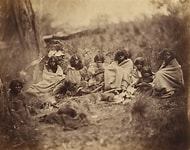
The History and Pioneers of Blackwood – The Blackwood District and Trentham.
Courtesy of Margot F Hitchcock, Historian for the Blackwood and District Historical society. May 2022.
History with grateful thanks to the following web site – https://bih.federation.edu.au/index.php/Trentham

Wurundjeri Aborigines courtesy Google.
The Trentham area was once amongst the lands inhabited by the Dja Dja Wurrung Aboriginal people. Although pastoral runs were taken up in the area as early as 1838, Trentham was first settled by gold prospectors in the 1850s, and later developed for its timber resources from the surrounding Wombat State Forest. In 1854 there were about a hundred people living in the area, mostly timber cutters, taking timber from the dense Bullarook forest. Gold was discovered in nearby Blackwood in 1854, and in the future Trentham township site in 1859, though the ground there was never particularly rich. (Info from Peter Parsons (ed), G W Trewhella, Early History of the Trentham District, Trentham Historical Society 1989 [1957].)
The first land sale in the Parish of Trentham was held in Kyneton in 1857. This followed a survey by John Wrigglesworth of land in the southern section of “Woodside”, formerly a pastoral run owned by Alexander Fullerton Mollison, then Thomas Clowes and subsequently by G. W. Johnston. Lots varying from 99 to 595 acres were offered for sale. It is presumed that the Parish name was given by Wrigglesworth during preparation of the sale plans and originated from the English town Trentham in Staffordshire.
In 1864 the township of Trentham was surveyed into half acre allotments by A. F. Wrigglesworth. The first land sale of township allotments occurred in December of the same year. The first blocks were purchased by Graham and Donald McPherson, Patrick Murphy and John Wolff. The township of Trentham was proclaimed in April 1867, presumably by notice in the Government Gazette.
By the end of the 1860s Trentham had a thriving business community, hotels, a brewery, a court house, churches and stores. The presence of Murphy’s Commercial Hotel on High Street, already existing before he purchased the land in 1865, established High Street as the business precinct of the town. (Info – Norm Darwin, Gold’n Spa. A History of the Hepburn Shire, Ballarat 2005, p 93.)
History of the Dja Dja Wurrung Aboriginal people. https://bih.federation.edu.au/index.php/Dja_Dja_Wurrung

Aborigines courtesy Google.
The Dja Dja Wurrung territory extended from Mount Franklin and the towns of Creswick and Daylesford in the southeast to Castlemaine, Maldon and Bendigo in the east, Boort in the north, Donald in the northwest, to Navarre Hill and Mount Avoca marking the south west boundary. Their territory encompassed the Bendigo and Clunes goldfields. The Dja Dja Wurrung were bound to their land by their spiritual belief system deriving from the Dreaming, when mythic beings had created the world, the people and their culture. They were part of established trade networks which allowed goods and information to flow over substantial distances. The Dja Dja Wurrung communities consisted of 16 land-owning groups called clans that spoke a related language and were connected through cultural and mutual interests, totems, trading initiatives and marriage ties. Access to land and resources by other clans, was sometimes restricted depending on the state of the resource in question. Around 1836 following the explorer Major Mitchell’s glowing reviews of the Dja Dja Wurrung Central Highlands territory, large numbers of pioneer pastoralists flocked to the promising new grazing lands. They took possession of vast tracts of land. As a result, the whole pattern of tribal life for the bewildered Aboriginal people was disrupted. The Colonial Government in London took steps to come to their aid by appointing a Chief Protector of Aborigines and four Assistant Protectors. One of these was Edward Stone Parker. In early 1840 Parker took a census which listed 282 individual men, women and children, “each one named, together with details of approximate age, sex and sub-tribal classification”. As result of his strong advocacy, Parker succeeded in the establishment in 1841 of an Aboriginal settlement at Franklinford near Daylesford. 127 Aboriginal people accompanied Edward Parker and his family from the commencement of the project. The Dja Dja Wurrung Clans Aboriginal Corporation website (http://www.djadjawurrung.com.au/) is dedicated to the Dja Dja Wurrung ancestors.
Newspaper reports from the ‘Kyneton Guardian’ newspaper as recorded in the book ‘History of Kyneton’ 1836-1900 Vol. 1. (Re-printed 1981)
16th August 1863
A party of sophisticated Aborigines visit Kyneton (three men, three lubras and a lad) and ask H.Glenny, the local photographer how much he will pay them for the privilege of photographing them. Native Corroborees frequently held in Kyneton, a favourite site being Mr.W.X. Johnson’s land on which Mr. H. Rawson’s shop now stands.
Information from my next book – ‘ Blackwood History and Pioneers’.
Betty’s Hill, north of Trentham, is so called because of a cairn of rocks, which is the grave of a small girl, by that name who was buried there in the very early days. The story is that she became lost in the dense forest of those days, and that her body was found some time later, some say by Aborigines and covered with rocks where she was found. One version is that she became lost while playing, and another is that she had set off to meet her father on the way home from his work.





